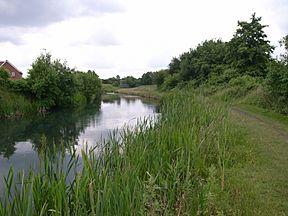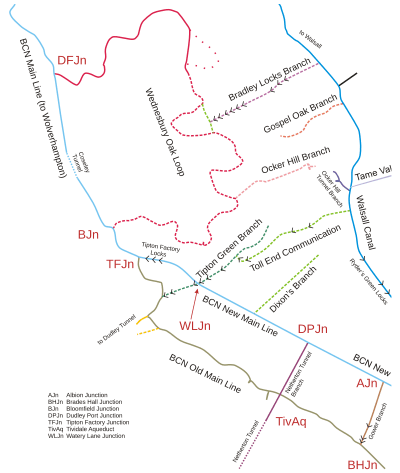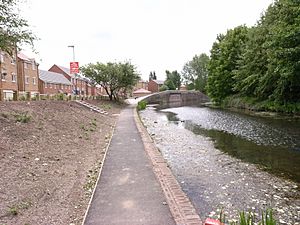Wednesbury Oak Loop facts for kids
Quick facts for kids Wednesbury Oak Loop |
|
|---|---|

A rural scene on the Wednesbury Oak Loop
|
|
| Specifications | |
| Status | Part open, Part destroyed |
| Navigation authority | Canal and River Trust |
| History | |
| Principal engineer | James Brindley |
| Date of act | 1768 |
| Date of first use | 1772 |
| Date completed | 1837 |
| Date closed | 1954 |
| Geography | |
| Start point | Bloomfield Junction |
| End point | Deepfields Junction |
| Branch of | Birmingham Canal Navigations |
The Wednesbury Oak Loop is a historic canal in the West Midlands, England. It's also known as the Bradley Arm. This canal is part of the larger Birmingham Canal Navigations (BCN) network.
It was first built as part of James Brindley's main canal line. Later, in the 1830s, Thomas Telford made big improvements. He built the Coseley Tunnel, which made the original route a "loop" instead of the main path. Over time, parts of the loop were closed. In 1954, the whole loop was officially "abandoned." Sections were filled in during the 1960s to build new areas, like the Glebefields Estate in Tipton.
Contents
Building the Wednesbury Oak Loop
The Wednesbury Oak Loop was one of the winding parts of the first Birmingham Canal. This canal was designed by James Brindley. He got permission to build it in 1768.
A section of the canal opened in 1769. It connected coal mines in Wednesbury to central Birmingham. The main part of the canal, which included the Wednesbury Oak Loop, started being built in 1770. This section was designed to stay at a certain height, avoiding locks.
Opening the Main Line
The main line of the canal opened on 21 September 1772. It ended with twenty locks at Wolverhampton. These locks lowered the canal to meet the Staffordshire and Worcestershire Canal. Some people thought Brindley made the canal extra long to charge more money. But Brindley said the winding route was needed to reach more customers.
Telford's Improvements and Changes
In 1824, a new engineer named Thomas Telford was asked to improve the main canal line. Telford was known for building canals in straighter lines. He used cuttings (digging through hills) and embankments (building up land) to make canals more direct.
The long, winding Wednesbury Oak Loop was a perfect place for Telford to make changes. Work began on a new, straighter path.
Building the Coseley Tunnel
By 1834, a new canal, the Birmingham and Liverpool Junction Canal, was about to open. This meant much more boat traffic was expected. So, in 1835, permission was given to build a tunnel. This tunnel, the Coseley Tunnel, was about 360 yards (329 meters) long.
The Coseley Tunnel opened on 6 November 1837. This new, direct route bypassed the old Wednesbury Oak Loop. The loop then connected to the new main line at Deepfields Junction and Bloomfield Junction. Telford's improvements made the main canal line much shorter. It went from 22.5 miles (36.2 km) to 15.5 miles (24.9 km). A big part of this reduction was due to bypassing the Wednesbury Oak Loop.
Other Branches and Closures
The Ocker Hill Branch was another canal branch that connected to the Wednesbury Oak Loop. It was about 0.6 miles (1 km) long and opened in 1774. This branch had steam engines that pumped water to higher parts of the canal.
Pumping Stations and Abandonment
There were five steam engines at the Ocker Hill pumping station in 1851. The tunnel for this branch needed repairs often because of mining. It was used until 1954 when it was "abandoned." The tunnel was filled in around 1960. Part of this filled-in area became the Glebefields housing estate.
In 1849, the Bradley Locks Branch opened. It connected the loop to the Walsall Canal. This was one of many new links made after different canal companies joined together. After it closed in 1961, much of it was covered up. It became part of a park. Some groups think it could be restored because many of its old structures are still there.
The Loop Today
In 1954, many parts of the BCN canals, including the Wednesbury Oak Loop, were abandoned. Sections were filled in and built over. The part near Glebefields Estate was filled in around 1961. The southern part was filled in about ten years later. An aqueduct (a bridge for water) over Central Avenue was taken down at this time.
Today, the northern part of the loop is still open for boats. It's sometimes called the Bradley Arm. This section goes to the British Waterways workshops in Bradley. Near the workshops is a modern pumping station. It pumps water from old coal mines into the canal.
Exploring the Route
| Map of Wednesbury Oak Loop (shown in pink), an original part of James Brindley's Birmingham Canal, and its modern neighbours. The canal as it stands today is shown as a solid line. |
The canal starts at Deepfields Junction. It goes under a railway bridge. There used to be a basin (a wide area for boats) here for a coal mine. This basin is now gone.
After that, the canal turned northeast in a wide curve. There were more basins here for different factories and coal mines. Many of these basins are now gone or filled in. Highfields Bridge carries Highfields Road over the canal. There's still a basin here that boats can use to turn around.
Industrial Past of the Canal
Further along, there was a very wide section of the canal. This acted as a basin and is the last place boats can turn around today. Many old factories and iron works were served by basins along this part of the canal. For example, Capponfield Furnaces and Barbor's Field Furnaces had basins.
Banks Bridge is where Dudley Street crosses the canal. The canal then makes a big curve to the south. More basins served places like Bradley Field Iron Works. Pothouse Bridge carries Salop Road over the canal, and another basin served the Regent Iron Works.
The old canal line used to swing in a big loop to the east. It passed by factories like Britannia and Bradley Hall Works. This loop ended where the modern British Waterways Works is now. A new, straighter path was cut across this loop before 1887.
Most of the old loop was dry by 1938. Tup Street Bridge crosses the canal just past where the watered section ends today. There were more basins for places like Batman's Hill Iron Works. Another large loop went to the west. It's now roughly where the Weddell Wynd Community Woodland is. This loop had basins for coal pits, but they are now gone.
Connecting Branches and Modern Sites
Before the Bradley Locks Branch opened in 1849, a straight cut was made across another loop. The new branch connected to this cut. East of this cut, there was a network of basins. These served the Wednesbury Oak Iron Works and furnaces that made pig iron.
Many old coal mines and factories had basins along this section. For example, Schoolfields Colliery No 2 and No 3 had basins, but they were not used by 1887. Schoolfields Colliery No 5 was active and had basins linked to tramways. Today, a modern school stands where one of these basins used to be.
After another big bend, Gospel Oak Iron Works and Summer Hill Iron Works had large basins. The canal made a big loop around the village of Summer Hill. This is where the Ocker Hill Branch left the main canal. There were also basins for Hope Colliery and Hope Iron Works. These were gone by 1904.
Church Lane crossed the canal southwest of Summer Hill. The final section of the canal had more bends and basins. These basins served old clay pits and Tipton Green Iron Furnaces. Several bridges, including tramway and railway bridges, crossed the canal here. Most of these basins were gone by 1920. The canal then rejoined the cut from Coseley Tunnel.
| Point | Coordinates (Links to map resources) |
OS Grid Ref | Notes |
|---|---|---|---|
| Deepfields Junction | 52°33′10″N 2°05′25″W / 52.5528°N 2.0904°W | SO938950 | BCN Main Line |
| Pothouse Bridge Junction | 52°33′31″N 2°03′58″W / 52.5585°N 2.0662°W | SO955956 | Loxdale Street |
| Current terminus | 52°33′13″N 2°03′58″W / 52.5536°N 2.0661°W | SO955951 | British Waterways workshops |
| Tup Street Bridge | 52°33′10″N 2°03′55″W / 52.5528°N 2.0654°W | SO955950 | |
| Ocker Hill Branch junction | 52°32′19″N 2°03′23″W / 52.5385°N 2.0564°W | SO961934 | (dry - estimated from map) |
| Bloomfield Junction | 52°32′06″N 2°04′46″W / 52.5351°N 2.0795°W | SO946930 | (dry) - Wednesbury Oak Loop originally rejoined the BCN Main Line |




